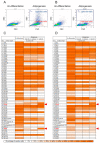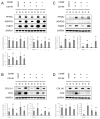CD49f and CD146: A Possible Crosstalk Modulates Adipogenic Differentiation Potential of Mesenchymal Stem Cells
- PMID: 38201259
- PMCID: PMC10778538
- DOI: 10.3390/cells13010055
CD49f and CD146: A Possible Crosstalk Modulates Adipogenic Differentiation Potential of Mesenchymal Stem Cells
Abstract
Background: The lack of appropriate mesenchymal stem cells (MSCs) selection methods has given the challenges for standardized harvesting, processing, and phenotyping procedures of MSCs. Genetic engineering coupled with high-throughput proteomic studies of MSC surface markers arises as a promising strategy to identify stem cell-specific markers. However, the technical limitations are the key factors making it less suitable to provide an appropriate starting material for the screening platform. A more accurate, easily accessible approach is required to solve the issues.
Methods: This study established a high-throughput screening strategy with forward versus side scatter gating to identify the adipogenesis-associated markers of bone marrow-derived MSCs (BMSCs) and tonsil-derived MSCs (TMSCs). We classified the MSC-derived adipogenic differentiated cells into two clusters: lipid-rich cells as side scatter (SSC)-high population and lipid-poor cells as SSC-low population. By screening the expression of 242 cell surface proteins, we identified the surface markers which exclusively found in lipid-rich subpopulation as the specific markers for BMSCs and TMSCs.
Results: High-throughput screening of the expression of 242 cell surface proteins indicated that CD49f and CD146 were specific for BMSCs and TMSCs. Subsequent immunostaining confirmed the consistent specific expression of CD49f and CD146 and in BMSCs and TMSCs. Enrichment of MSCs by CD49f and CD146 surface markers demonstrated that the simultaneous expression of CD49f and CD146 is required for adipogenesis and osteogenesis of mesenchymal stem cells. Furthermore, the fate decision of MSCs from different sources is regulated by distinct responses of cells to differentiation stimulations despite sharing a common CD49f+CD146+ immunophenotype.
Conclusions: We established an accurate, robust, transgene-free method for screening adipogenesis associated cell surface proteins. This provided a valuable tool to investigate MSC-specific markers. Additionally, we showed a possible crosstalk between CD49f and CD146 modulates the adipogenesis of MSCs.
Keywords: CD146; CD49f; high-throughput screening; light scatter gating; mesenchymal stem cell-specific markers.
Conflict of interest statement
The authors declare no conflict of interest.
Figures






Similar articles
-
Cell-surface expression of neuron-glial antigen 2 (NG2) and melanoma cell adhesion molecule (CD146) in heterogeneous cultures of marrow-derived mesenchymal stem cells.Tissue Eng Part A. 2013 Oct;19(19-20):2253-66. doi: 10.1089/ten.TEA.2012.0649. Epub 2013 May 30. Tissue Eng Part A. 2013. PMID: 23611563 Free PMC article.
-
CD49f Acts as an Inflammation Sensor to Regulate Differentiation, Adhesion, and Migration of Human Mesenchymal Stem Cells.Stem Cells. 2015 Sep;33(9):2798-810. doi: 10.1002/stem.2063. Epub 2015 Jun 23. Stem Cells. 2015. PMID: 26013602
-
Evaluation of CD49f as a novel surface marker to identify functional adipose-derived mesenchymal stem cell subset.Cell Prolif. 2021 May;54(5):e13017. doi: 10.1111/cpr.13017. Epub 2021 Mar 11. Cell Prolif. 2021. PMID: 33704842 Free PMC article.
-
Tensin-3 Regulates Integrin-Mediated Proliferation and Differentiation of Tonsil-Derived Mesenchymal Stem Cells.Cells. 2019 Dec 30;9(1):89. doi: 10.3390/cells9010089. Cells. 2019. PMID: 31905841 Free PMC article.
-
Reciprocal Effect of Environmental Stimuli to Regulate the Adipogenesis and Osteogenesis Fate Decision in Bone Marrow-Derived Mesenchymal Stem Cells (BM-MSCs).Cells. 2023 May 16;12(10):1400. doi: 10.3390/cells12101400. Cells. 2023. PMID: 37408234 Free PMC article. Review.
Cited by
-
Melanoma Cell Adhesion Molecule (CD 146) in Endometrial Physiology and Disorder.Adv Exp Med Biol. 2025;1474:131-148. doi: 10.1007/5584_2024_826. Adv Exp Med Biol. 2025. PMID: 39400880 Review.
-
A Systematic Review on the Effectiveness and Safety of Combining Biostimulators with Botulinum Toxin, Dermal Fillers, and Energy-Based Devices.Aesthetic Plast Surg. 2025 May;49(10):2809-2833. doi: 10.1007/s00266-024-04627-5. Epub 2024 Dec 24. Aesthetic Plast Surg. 2025. PMID: 39719485
-
Induced Pluripotent (iPSC) and Mesenchymal (MSC) Stem Cells for In Vitro Disease Modeling and Regenerative Medicine.Int J Mol Sci. 2025 Jun 11;26(12):5617. doi: 10.3390/ijms26125617. Int J Mol Sci. 2025. PMID: 40565081 Free PMC article. Review.
-
Immunosenescence and cancer: molecular hallmarks, tumor microenvironment remodeling, and age-specific immunotherapy challenges.J Hematol Oncol. 2025 Aug 22;18(1):81. doi: 10.1186/s13045-025-01735-w. J Hematol Oncol. 2025. PMID: 40846970 Review.
References
Publication types
MeSH terms
Substances
Grants and funding
LinkOut - more resources
Full Text Sources

